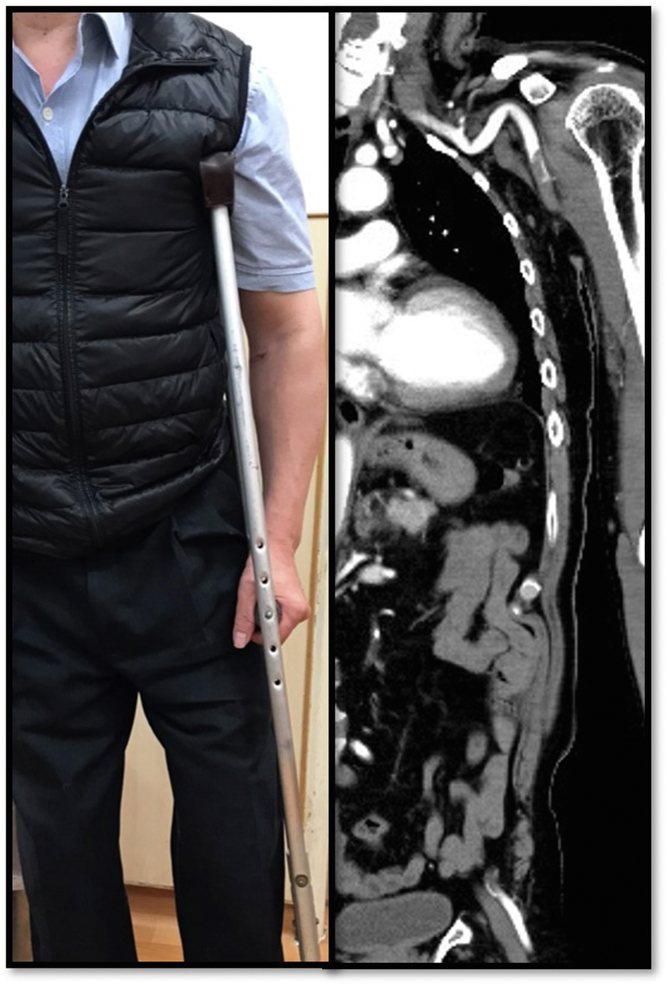A 61-year-old man was admitted to our institution with worsening numbness, pallor, and weakness in his left forearm of several days’ duration. His medical history indicated childhood poliomyelitis with a shortening deformity of the left leg, and he had been using one axillary crutch since his adolescence. No history of heart-related condition or diabetes was reported. The physical examination showed a cold, pale left forearm, with diminished pulsations of the left radial and brachial arteries. Computed tomography angiography showed a distorted left axillary artery with acute thrombosis that affected the left axillary artery and downstream vessels without collateral circulation (A). Emergent surgical exploration of the brachial artery through the antecubital fossa was performed, and a freshly formed intraluminal clot was extracted using balloon thromboembolectomy both proximally and distally (B and Supplementary Video, online only). Intraoperative duplex ultrasound confirmed patent, pulsatile triphasic arterial flow through the bifurcation before closing. Brisk arterial pulsations at the wrist level had recovered immediately after the procedure. The patient recovered well and was referred to our rehabilitation clinic for assessment and crutch training. The patient provided written informed consent for the report of his case details and imaging studies.
Crutch-induced vascular injury is a rarely reported condition in long-term crutch users1; however, the effects of its unique pathophysiology can lead to arterial thrombosis and acute or chronic upper limb ischemia.2 Incorrect use of the crutches can transfer 34% of the body weight to the axilla instead of the chest wall, contribute to a sevenfold increase in the force against the axilla, and cause repetitive trauma to the axillobrachial arteries.1,3 The vascular injury can result in aneurysm formation, vessel distortion, and/or stenosis.4 Moreover, the axillary artery can dynamically become nearly occluded when tremendous force is applied by the crutch over the armpit, causing downstream arterial flow stasis and formation of thrombosis. For our patient, who had developed acute upper limb ischemia, we believe surgical thromboembolectomy for limb salvage was justified to prevent limb loss. More important was educating the patient to use the crutch correctly to avoid direct armpit compression and the occurrence of acute arterial thrombosis.

Footnotes
Author conflict of interest: none.
The editors and reviewers of this article have no relevant financial relationships to disclose per the Journal policy that requires reviewers to decline review of any manuscript for which they may have a conflict of interest.
Additional material for this article may be found online at https://www.jvscit.org.
Appendix (online only).
Cover image.
References
- 1.Moon I.S., Hwang J.K., Kim J.I. Recurrent upper extremity embolism due to a crutch-induced arterial injury: a different cause of upper extremity embolism. Ann Vasc Surg. 2010;24:554.e7–554.e12. doi: 10.1016/j.avsg.2009.11.005. [DOI] [PubMed] [Google Scholar]
- 2.McFall B., Arya N., Soong C., Lee B., Hannon R. Crutch induced axillary artery injury. Ulster Med J. 2004;73:50–52. [PMC free article] [PubMed] [Google Scholar]
- 3.Ang E.J., Goh J.C., Bose K., Toh S.L., Choo A. Biofeedback device for patients on axillary crutches. Arch Phys Med Rehabil. 1989;70:644–647. [PubMed] [Google Scholar]
- 4.Furukawa K., Hayase T., Yano M. Recurrent upper limb ischaemia due to a crutch-induced brachial artery aneurysm. Interact Cardiovasc Thorac Surg. 2013;17:190–192. doi: 10.1093/icvts/ivt121. [DOI] [PMC free article] [PubMed] [Google Scholar]
Associated Data
This section collects any data citations, data availability statements, or supplementary materials included in this article.



